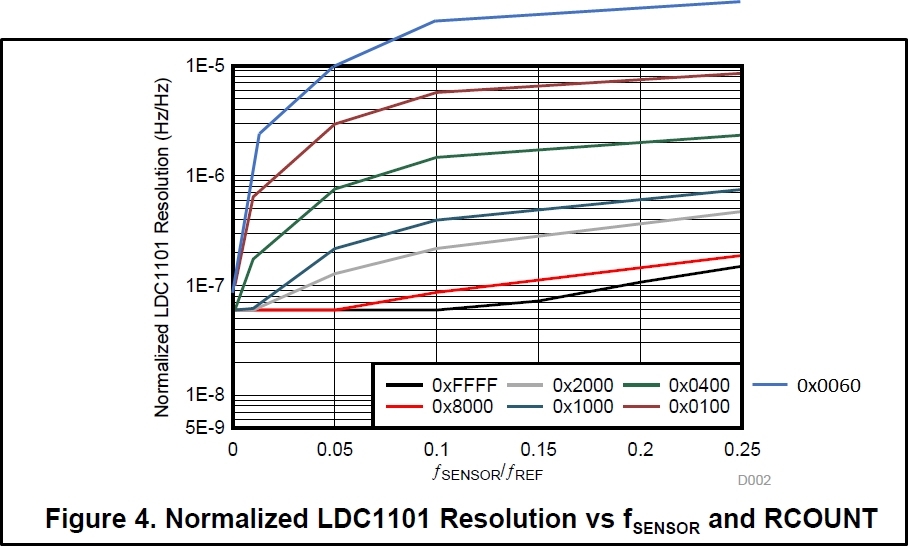Other Parts Discussed in Thread: LDC1614
Hello there,
I have question related to LDC1101 RCOUNT, corresponding sample rate and way to estimate resolution.
- My design is wire winded coil which operates 0.05-0.1 target distance/coil diameter. Fref is 16MHz.
- Sensor operation frequency can be set to any value from 0.7-4 MHz. For best resolution I chose 0.8 MHz for middle of measurement range which gives (0.05 fsensor/fref). I believe that this is correct assumption.
- Sensor frequency variation is 10-15% of LDC1101 supported frequency (9.5 MHz).
1. SAMPLE RATE
I need to have at least 10kHz sample rate. That gives me from equation 14 (snosd01d):
tconv = 100 usec (total time for conversion)
tpost_conv = 55/16MHz = 3.44 usec (fixed post process time)
tmeas = RCOUNT*16/16MHz =~ 96 usec (time left for measurement, HEX: 0x0060)
sample rate is then 1/tconv = 16000000 / ((3.44+96 * 16)) = 10.394 kHz.
This gives data latency (time from start of measurement to output data reading) 100 usec correct?
2. RCOUNT and RESOLUTION
I understand that with increasing sample rate the effective resolution decreases. Effective resolution is function f(RCOUNT, nominal fsensor, sensor variation,fsensor/fref).
In section LHR Sample Rate Configuration With RCOUNT is an example: 2^13 = 8192 clock cycles then there will be effective resolution will be 13 bits. RCOUNT is calculated as 8192 decimal (btw I believe that 8192 is in HEX: 0x2000 not 0x0200)
How do I get maximum effective resolution of 24 bits if RCOUNT can go just upto 65535? RCOUNT varies 2^1 (6.5 bits) -> 2^16 (24 bits) but 2^13 is 13 bits?
I also read manual snoa944 where on figure 4 is shown normalized resolution. I need to calculate resolution for RCOUNT 96. What equation is behind this graph at figure 4?
When I extrapolate setting 0x0060 for fsensor/fref 0.05 I get approximate resolution of 1e-5 Hz/Hz which is for fref 16MHz 160Hz (1e-5*16*e6). If I assume that sensor frequency variation is 10% (0.95MHz) then entire resolution is 950000Hz/160Hz = 5937 values =~ 12.5 bits of resolution. Um resolution for range of measurement 2000 um = 2000/2^12.5 = 0.345 um correct?
How do I calculate frequency resolution for my case?
What would be the achievable resolution for setting RCOUNT 96 (10kHz) and how can I increase it with keeping same sample time?
I really appreciate your help.
Thank you,
Michael




